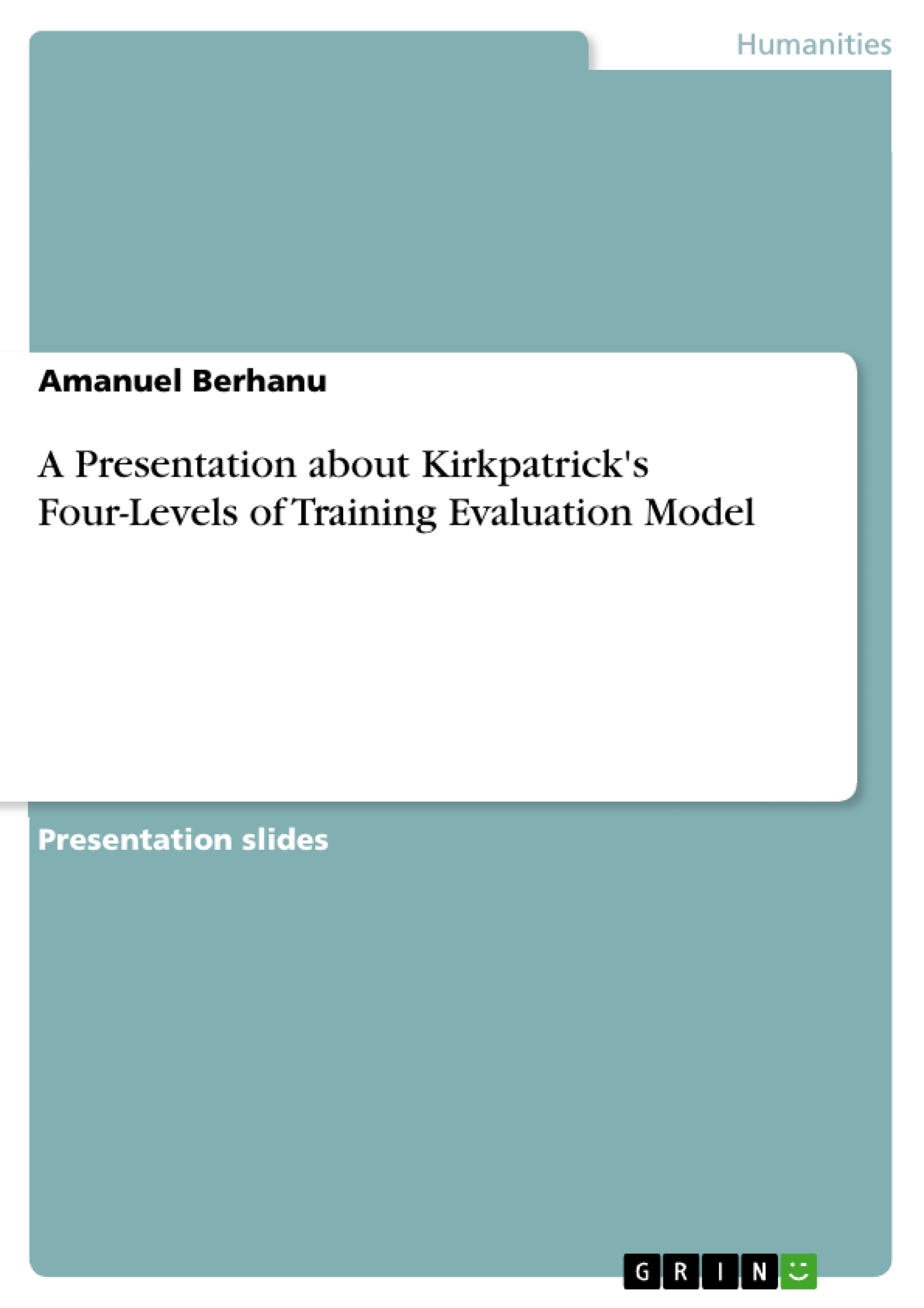Unlock the secrets to transformative training with an insightful exploration of Kirkpatrick's Four-Level Training Evaluation Model, a cornerstone of effective program assessment. Delve into the fundamental purpose and critical need for rigorous training evaluation, understanding why it's essential for organizations seeking to optimize their learning and development investments. This comprehensive analysis dissects the model's enduring popularity while confronting its inherent limitations, offering a balanced perspective for practitioners and academics alike. Explore the nuances of each level – Reaction, Learning, Behavior, and Results – gaining a practical understanding of how to measure training effectiveness across diverse sectors, from business and government to military and industrial settings. Discover how to apply this time-tested framework to enhance program design, justify training expenditures, and drive measurable improvements in employee performance and organizational outcomes. Uncover the strengths and weaknesses of Kirkpatrick's methodology through a meticulous review of existing literature, including scholarly journals, seminal books, and authoritative websites. This examination provides invaluable insights into the model's application, its potential pitfalls, and strategies for maximizing its impact. Whether you're a seasoned training professional or a newcomer to the field, this resource offers a clear and concise guide to mastering Kirkpatrick's Four-Levels, empowering you to create training programs that deliver tangible and lasting results. Discover effective evaluation methods and data collection techniques to enhance training effectiveness. Learn how to critically assess training initiatives and make informed decisions that contribute to organizational success through comprehensive program evaluation. This is your guide to understanding and implementing a proven framework for measuring the true impact of training.
Table of Contents
- 1. INTRODUCTION
- 1.1. Background of the review
- 1.2 Objectives of the review
- 2. METHODOLOGY
- 3. LITERATURE REVIEW
- 3.1. Purpose and need of training evaluation
- 3.2 Kirkpatrick's Four-Levels of Training Evaluation Model
- 3.2.1 Level 1- Reaction
Objectives and Key Themes
This paper reviews Kirkpatrick's four-level training evaluation model. It explores the purpose and need for training evaluation, examining the model's popularity and limitations. The review utilizes secondary data sources such as journals, books, and websites.
- Kirkpatrick's Four-Levels of Training Evaluation Model
- The Purpose and Need for Training Evaluation
- Evaluation Methods and Data Collection
- Application of the Model in Various Sectors
- Limitations and Criticisms of the Model
Chapter Summaries
1. INTRODUCTION: This introductory chapter sets the stage by defining training evaluation and its significance. It introduces Donald Kirkpatrick and his seminal contribution – the four-level training evaluation model. The chapter establishes the context for the paper, highlighting the model's historical background and its wide application across various sectors, including business, government, military, and industrial training. The objectives of the review are clearly stated, focusing on a comprehensive examination of Kirkpatrick's model, its purpose, and its limitations.
2. METHODOLOGY: This chapter outlines the research methodology employed in the paper. It explicitly states that the paper is based solely on a review of secondary data, including journals, books, and websites. This transparently establishes the research approach and its limitations, emphasizing the reliance on existing literature for the analysis and discussion of Kirkpatrick's model.
3. LITERATURE REVIEW: This chapter delves into the core subject matter, providing a comprehensive review of the literature on Kirkpatrick's four-level model. It begins by exploring the purpose and need for training evaluation in general, outlining its importance for organizations in achieving training objectives, justifying costs, and improving future program design. The main focus then shifts to Kirkpatrick's model itself, breaking down its four levels (reaction, learning, behavior, and results) and their respective implications. The chapter likely examines each level in detail, analyzing how each contributes to the overall effectiveness of a training program. While the provided text only includes a small glimpse of Level 1 (Reaction), a complete chapter would comprehensively cover all four levels. The chapter likely analyzes how the model's different levels contribute to a comprehensive understanding of training effectiveness.
Keywords
Kirkpatrick's Four-Levels, Training Evaluation, Reaction, Learning, Behavior, Results, Training Effectiveness, Program Evaluation, Methodology, Literature Review.
Häufig gestellte Fragen
Was ist das Hauptziel dieser Dokumentenübersicht?
Diese Dokumentenübersicht bietet eine Vorschau auf eine akademische Arbeit, die sich mit dem Vier-Ebenen-Modell von Kirkpatrick zur Trainingsevaluation befasst. Sie umfasst Inhaltsverzeichnis, Zielsetzungen, Themenschwerpunkte, Zusammenfassungen der Kapitel und Schlüsselwörter.
Welche Themen werden in der Arbeit behandelt?
Die Arbeit konzentriert sich auf Kirkpatrick's Vier-Ebenen-Modell zur Trainingsevaluation. Hauptthemen sind der Zweck und die Notwendigkeit von Trainingsevaluation, die Anwendung des Modells in verschiedenen Sektoren sowie die Grenzen und Kritikpunkte des Modells.
Welche Methodik wird in der Arbeit verwendet?
Die Arbeit basiert auf einer Literaturrecherche, d.h. auf der Analyse von Sekundärdaten wie Fachzeitschriften, Büchern und Webseiten.
Was sind die vier Ebenen von Kirkpatrick's Modell?
Kirkpatrick's Vier-Ebenen-Modell umfasst: Reaktion (Reaction), Lernen (Learning), Verhalten (Behavior) und Ergebnisse (Results). Die Dokumentenübersicht gibt einen kurzen Einblick in Ebene 1 (Reaktion), während die vollständige Arbeit alle vier Ebenen detailliert untersucht.
Welche Schlüsselwörter sind relevant für diese Arbeit?
Relevante Schlüsselwörter sind: Kirkpatrick's Vier-Ebenen-Modell, Trainingsevaluation, Reaktion, Lernen, Verhalten, Ergebnisse, Trainingseffektivität, Programmevaluation, Methodologie, Literaturrecherche.
Was ist die Bedeutung des Einführungskapitels?
Das Einführungskapitel definiert Trainingsevaluation und ihre Bedeutung. Es stellt Donald Kirkpatrick und sein Modell vor und erläutert dessen historischen Hintergrund und breite Anwendung in verschiedenen Sektoren.
Was wird im Kapitel zur Methodik beschrieben?
Das Kapitel zur Methodik beschreibt, dass die Arbeit auf einer reinen Literaturrecherche basiert und die Verwendung von Sekundärdaten aus Journals, Büchern und Webseiten darlegt.
Was beinhaltet das Kapitel zur Literaturrecherche?
Das Kapitel zur Literaturrecherche bietet einen umfassenden Überblick über die Literatur zu Kirkpatrick's Vier-Ebenen-Modell, beginnend mit dem Zweck und der Notwendigkeit von Trainingsevaluation im Allgemeinen. Es untersucht detailliert die vier Ebenen des Modells und deren jeweilige Auswirkungen.
- Quote paper
- Amanuel Berhanu (Author), 2018, A Presentation about Kirkpatrick's Four-Levels of Training Evaluation Model, Munich, GRIN Verlag, https://www.grin.com/document/425431




